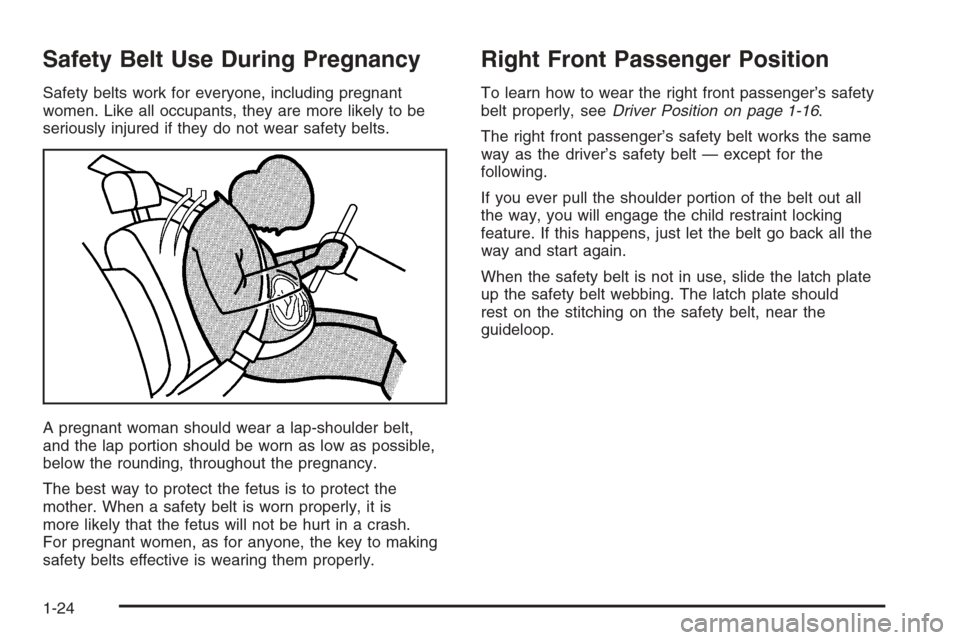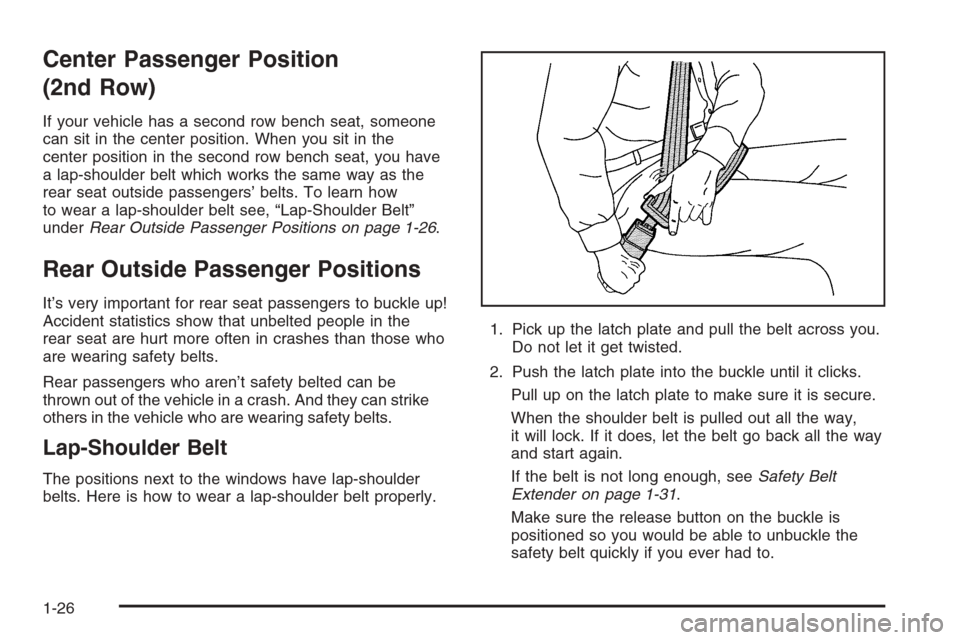Page 27 of 406
Q:What is wrong with this?
A:The shoulder belt is worn under the arm. It should
be worn over the shoulder at all times.
{CAUTION:
You can be seriously injured if you wear the
shoulder belt under your arm. In a crash, your
body would move too far forward, which would
increase the chance of head and neck injury.
Also, the belt would apply too much force to
the ribs, which are not as strong as shoulder
bones. You could also severely injure internal
organs like your liver or spleen.
1-21
Page 28 of 406
Q:What is wrong with this?
A:The belt is twisted across the body.
{CAUTION:
You can be seriously injured by a twisted belt.
In a crash, you would not have the full width of
the belt to spread impact forces. If a belt is
twisted, make it straight so it can work
properly, or ask your dealer to �x it.
1-22
Page 29 of 406
To unlatch the belt, just push the button on the buckle.
The belt should go back out of the way.
Before you close the door, be sure the belt is out of the
way. If you slam the door on it, you can damage
both the belt and your vehicle.
Shoulder Belt Height Adjustment
Before you begin to drive, move the shoulder belt height
adjuster to the height that is right for you.
Adjust the height so that the shoulder portion of the belt
is centered on your shoulder. The belt should be
away from your face and neck, but not falling off your
shoulder. Improper shoulder belt height adjustment
could reduce the effectiveness of the safety belt
in a crash.
To move it down, pull on
the center adjuster control
labeled PULL. You can
move the height adjuster
up just by pushing up
on the shoulder belt guide.
After you move the height adjuster to where you want it,
try to move it down without pushing in to make sure it
has locked into position.
1-23
Page 30 of 406

Safety Belt Use During Pregnancy
Safety belts work for everyone, including pregnant
women. Like all occupants, they are more likely to be
seriously injured if they do not wear safety belts.
A pregnant woman should wear a lap-shoulder belt,
and the lap portion should be worn as low as possible,
below the rounding, throughout the pregnancy.
The best way to protect the fetus is to protect the
mother. When a safety belt is worn properly, it is
more likely that the fetus will not be hurt in a crash.
For pregnant women, as for anyone, the key to making
safety belts effective is wearing them properly.
Right Front Passenger Position
To learn how to wear the right front passenger’s safety
belt properly, seeDriver Position on page 1-16.
The right front passenger’s safety belt works the same
way as the driver’s safety belt — except for the
following.
If you ever pull the shoulder portion of the belt out all
the way, you will engage the child restraint locking
feature. If this happens, just let the belt go back all the
way and start again.
When the safety belt is not in use, slide the latch plate
up the safety belt webbing. The latch plate should
rest on the stitching on the safety belt, near the
guideloop.
1-24
Page 31 of 406
Center Passenger Position
(3rd, 4th and 5th Row)
Lap Belt
If your vehicle has third, fourth or fifth row bench seats,
someone can sit in the center positions.
When you sit in a center seating position in the third,
fourth or fifth row, you have a lap safety belt, which has
no retractor. To make the belt longer, tilt the latch
plate and pull it along the belt.To make the belt shorter, pull its free end as shown
until the belt is snug.
Buckle, position and release it the same way as the lap
part of a lap-shoulder belt. If the belt isn’t long enough,
seeSafety Belt Extender on page 1-31.
Make sure the release button on the buckle is positioned
so you would be able to unbuckle the safety belt quickly if
you ever had to.
1-25
Page 32 of 406

Center Passenger Position
(2nd Row)
If your vehicle has a second row bench seat, someone
can sit in the center position. When you sit in the
center position in the second row bench seat, you have
a lap-shoulder belt which works the same way as the
rear seat outside passengers’ belts. To learn how
to wear a lap-shoulder belt see, “Lap-Shoulder Belt”
underRear Outside Passenger Positions on page 1-26.
Rear Outside Passenger Positions
It’s very important for rear seat passengers to buckle up!
Accident statistics show that unbelted people in the
rear seat are hurt more often in crashes than those who
are wearing safety belts.
Rear passengers who aren’t safety belted can be
thrown out of the vehicle in a crash. And they can strike
others in the vehicle who are wearing safety belts.
Lap-Shoulder Belt
The positions next to the windows have lap-shoulder
belts. Here is how to wear a lap-shoulder belt properly.1. Pick up the latch plate and pull the belt across you.
Do not let it get twisted.
2. Push the latch plate into the buckle until it clicks.
Pull up on the latch plate to make sure it is secure.
When the shoulder belt is pulled out all the way,
it will lock. If it does, let the belt go back all the way
and start again.
If the belt is not long enough, seeSafety Belt
Extender on page 1-31.
Make sure the release button on the buckle is
positioned so you would be able to unbuckle the
safety belt quickly if you ever had to.
1-26
Page 33 of 406
3. To make the lap part tight, pull down on the buckle
end of the belt as you pull up on the shoulder part.
The lap part of the belt should be worn low and snug on
the hips, just touching the thighs. In a crash, this applies
force to the strong pelvic bones. And you would be less
likely to slide under the lap belt. If you slid under it, the
belt would apply force at your abdomen. This could cause
serious or even fatal injuries. The shoulder belt should go
over the shoulder and across the chest. These parts of
the body are best able to take belt restraining forces.
1-27
Page 34 of 406

The safety belt locks if there is a sudden stop or a crash.
{CAUTION:
You can be seriously hurt if your shoulder belt
is too loose. In a crash, you would move
forward too much, which could increase injury.
The shoulder belt should �t against your body.
To unlatch the belt, push the button on the buckle.
For outboard seating positions, when the safety belt is
not in use, slide the latch plate up the safety belt webbing.
The latch plate should rest on the stitching on the safety
belt, near the guide loop on the side wall.
Rear Safety Belt Comfort Guides
Rear safety belt comfort guides may provide added
safety belt comfort for older children who have outgrown
booster seats and for some adults. When installed on
a shoulder belt, the comfort guide positions the belt
away from the neck and head.
There is one guide for each outside passenger position
in the rear seats. Here is how to install a comfort
guide and use the safety belt:
1. Locate the guide in a pocket on the side of the
seatback.
1-28